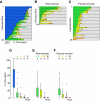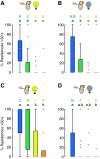Object preference by walking fruit flies, Drosophila melanogaster, is mediated by vision and graviperception
- PMID: 20581279
- PMCID: PMC2892423
- DOI: 10.1242/jeb.041749
Object preference by walking fruit flies, Drosophila melanogaster, is mediated by vision and graviperception
Abstract
Walking fruit flies, Drosophila melanogaster, use visual information to orient towards salient objects in their environment, presumably as a search strategy for finding food, shelter or other resources. Less is known, however, about the role of vision or other sensory modalities such as mechanoreception in the evaluation of objects once they have been reached. To study the role of vision and mechanoreception in exploration behavior, we developed a large arena in which we could track individual fruit flies as they walked through either simple or more topologically complex landscapes. When exploring a simple, flat environment lacking three-dimensional objects, flies used visual cues from the distant background to stabilize their walking trajectories. When exploring an arena containing an array of cones, differing in geometry, flies actively oriented towards, climbed onto, and explored the objects, spending most of their time on the tallest, steepest object. A fly's behavioral response to the geometry of an object depended upon the intrinsic properties of each object and not a relative assessment to other nearby objects. Furthermore, the preference was not due to a greater attraction towards tall, steep objects, but rather a change in locomotor behavior once a fly reached and explored the surface. Specifically, flies are much more likely to stop walking for long periods when they are perched on tall, steep objects. Both the vision system and the antennal chordotonal organs (Johnston's organs) provide sufficient information about the geometry of an object to elicit the observed change in locomotor behavior. Only when both these sensory systems were impaired did flies not show the behavioral preference for the tall, steep objects.
Figures











Similar articles
-
The influence of visual landscape on the free flight behavior of the fruit fly Drosophila melanogaster.J Exp Biol. 2002 Feb;205(Pt 3):327-43. doi: 10.1242/jeb.205.3.327. J Exp Biol. 2002. PMID: 11854370
-
The relative roles of vision and chemosensation in mate recognition of Drosophila melanogaster.J Exp Biol. 2014 Aug 1;217(Pt 15):2796-805. doi: 10.1242/jeb.105817. Epub 2014 Jun 4. J Exp Biol. 2014. PMID: 24902744
-
Virtual-reality techniques resolve the visual cues used by fruit flies to evaluate object distances.Curr Biol. 2002 Sep 17;12(18):1591-4. doi: 10.1016/s0960-9822(02)01141-7. Curr Biol. 2002. PMID: 12372251
-
Auditory system of fruit flies.Hear Res. 2016 Aug;338:1-8. doi: 10.1016/j.heares.2015.10.017. Epub 2015 Nov 10. Hear Res. 2016. PMID: 26560238 Review.
-
Neuronal encoding of sound, gravity, and wind in the fruit fly.J Comp Physiol A Neuroethol Sens Neural Behav Physiol. 2013 Apr;199(4):253-62. doi: 10.1007/s00359-013-0806-x. Epub 2013 Mar 13. J Comp Physiol A Neuroethol Sens Neural Behav Physiol. 2013. PMID: 23494584 Review.
Cited by
-
Modeling Drosophila positional preferences in open field arenas with directional persistence and wall attraction.PLoS One. 2012;7(10):e46570. doi: 10.1371/journal.pone.0046570. Epub 2012 Oct 10. PLoS One. 2012. PMID: 23071591 Free PMC article.
-
Spatio-temporal dynamics of impulse responses to figure motion in optic flow neurons.PLoS One. 2015 May 8;10(5):e0126265. doi: 10.1371/journal.pone.0126265. eCollection 2015. PLoS One. 2015. PMID: 25955416 Free PMC article.
-
A neurogenetic mechanism of experience-dependent suppression of aggression.Sci Adv. 2022 Sep 9;8(36):eabg3203. doi: 10.1126/sciadv.abg3203. Epub 2022 Sep 7. Sci Adv. 2022. PMID: 36070378 Free PMC article.
-
Diverse Food-Sensing Neurons Trigger Idiothetic Local Search in Drosophila.Curr Biol. 2019 May 20;29(10):1660-1668.e4. doi: 10.1016/j.cub.2019.03.004. Epub 2019 May 2. Curr Biol. 2019. PMID: 31056390 Free PMC article.
-
Internal states drive nutrient homeostasis by modulating exploration-exploitation trade-off.Elife. 2016 Oct 22;5:e19920. doi: 10.7554/eLife.19920. Elife. 2016. PMID: 27770569 Free PMC article.
References
-
- Armstrong J. D., Texada M. J., Munjaal R., Baker D. A., Beckingham K. M. (2006). Gravitaxis in Drosophila melanogaster: a forward genetic screen. Genes, Brain Behav. 5, 222-239 - PubMed
-
- Baker D. A., Beckingham K. M., Armstrong J. D. (2007). Functional dissection of the neural substrates for gravitaxic maze behavior in Drosophila melanogaster. J. Comp. Neurol. 501, 756-764 - PubMed
-
- Beckingham K. M., Texada M. J., Baker D. A., Munjaal R., Armstrong J. D. (2005). Genetics of graviperception in animals. Adv. Genet. 55, 105-145 - PubMed
-
- Bell W. J. (1991). Searching Behaviour: the Behavioural Ecology of Finding Resources New York: Chapman and Hall;
Publication types
MeSH terms
Grants and funding
LinkOut - more resources
Full Text Sources
Other Literature Sources
Molecular Biology Databases

